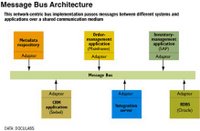Bus Architecture

1. A de-centralised architecture.
2. Network BUS acts as a message carrier.
3. Communication pattern is peer-peer.
4. Messages queued up by publisher.
This particular architecture is used in TIBCO.
Hubble-Spoke Architecture
 1. It’s a centralised architecture.
1. It’s a centralised architecture.2. Hub acts as a server & all messages flow through hub.
3. Communication pattern is Pubslish-Server & Server-Subscriber..
4. Messages queued up in the server.
This architecture is used by Webmethods.
Every integration solutions in someway or the other needs to make optimal use of the basic technologies like messaging, routing, translation, transformation, but architecture enables enterprises to implement it strategically & tactically. This helps in minimizing costs by reusing the components as well.
Good architecture will enable the solutions to be plugged in to the infrastructure flexibly. So building an overall architecture is an investment in itself.

No comments:
Post a Comment